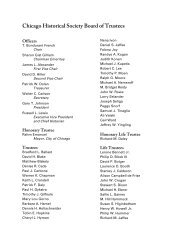The Beach Boys: Chicago's First Junior Lifeguards
The Beach Boys: Chicago's First Junior Lifeguards
The Beach Boys: Chicago's First Junior Lifeguards
Create successful ePaper yourself
Turn your PDF publications into a flip-book with our unique Google optimized e-Paper software.
organized group. Each boy helped watch a designatedarea of the beach before the season officially started andduring busy hours, and would report any trouble in thewater to the lifeguards. In reward for their services, thejunior guards received T-shirts and swim trunks; in theirfree time, they also got to practice with rowboats,canoes, and other equipment. <strong>Junior</strong> guards also had theinside track on future lifeguard positions. At Rogers Park,the first junior guard crew included Bob Dooley and FranConway, who would both be associated with the beachfor decades.Other than the T-shirts and the rowboats, juniorguarding was a somewhat sedate, thankless job in theearly days. With only twelve to twenty boys in the programin the early 1920s, junior guarding lacked the socialelement for which it would later be known. <strong>The</strong> patrolstended to be very tedious, consisting of hot days spentwatching a little stretch of beach while other youngstersperformed cannonballs off the Touhy <strong>Beach</strong> diving platform.Occasionally, however, the junior guards saw action.In August 1924, the Casmere, a thirty-five-foot sloopsailing from Belmont Harbor, got stuck on a sandbarabout fifty yards off Chase Avenue. As the surf poundedthe boat, the five passengers knew the Casmere wouldbreak apart in minutes. Six junior guards—Bob Dooley,Buddy Edwards, Bob Franks, Harry Sutherland, PeteObermeyer, and Byron Speares—launched the crew boat,an old twenty-six-foot Coast Guard surfboat. Dooley andhis mates rowed over to the Casmere and, by rocking theboat back and forth during each break in the waves,freed the sloop in eight minutes, the first recorded rescuemade by Rogers Park junior guards.Within a few years, Superintendent Daly’s juniorguard crews stagnated at Clarendon and Rainbow<strong>Beach</strong>es, but the program took off in Rogers Park. Onereason for the Rogers Park program’s success could bethe fact that Daly lived in a city-owned house rightbehind Touhy <strong>Beach</strong>; possibly he kept a closer eye on hishome neighborhood program. In 1926, Touhy <strong>Beach</strong>boasted 30 junior guards, while Clarendon—the city’sbiggest beach—had only 14. <strong>The</strong> Rogers Park <strong>Beach</strong> programgrew rapidly, tallying 64 boys in 1929, 90 in 1931,and 160 by 1939. <strong>The</strong> boom could be traced to two factors:Rogers Park’s growth as a residential neighborhoodwith many families, and beach director Sam Leone.Leone, a short, muscular, chain-smoking Sicilian immigrantand World War I Navy veteran, arrived at Touhy<strong>Beach</strong> in 1925 at age twenty-five, after spending fiveyears as a lifeguard at Clarendon. A high-school dropout,Leone proved to be a capable administrator who pioneeredmany lifeguarding and lifesaving techniques. AsLeone himself put it, “We teach them to be happy in thewater and feel just as much at home in the lake as theywould in their own home.”<strong>The</strong> 1916 Annual Report on Parks and <strong>Beach</strong>es ranked attendanceat beaches and pools for the year. <strong>The</strong> number of Chicagoanswho swam recreationally increased more than 200 percent between1915 and 1916, foreshadowing how popular the beaches wereabout to become.Leone was one of the first guards to advocate “preventive”lifeguarding—keeping beachgoers out of troubleinstead of making dramatic rescues on swimmers whohad already gone down. Leone also was the first Chicagolifeguard to make use of a variety of new technologies toaid rescue attempts. He pioneered the diving helmet;portable resuscitators to inflate drowning victims’ lungs;two-way radios for emergency communication; and useof the “Aqua Lung,” now known as SCUBA, for rescueand recovery. During his forty years at Rogers Park<strong>Beach</strong>, Leone personally made more than five hundredrescues, and his lifeguards and junior guards saved morethan ten thousand lives, while losing fewer than ten—arecord that, according to the Chicago Sun-Times, “wasbelieved to be unmatched anywhere.”Yesterday’s City | 43
Leone achieved these results by establishing strictrules for both his lifeguards and his junior guards. Herequired his guards to be at work on time, and to respectauthority figures. <strong>The</strong> hot-tempered Leone fired dozensof lifeguards and expelled many junior guards for smalltransgressions, although he often relented after makinghis point. “Sam Leone was the Vince Lombardi of lifeguarding,”1940s junior guard Ed Kahn said. “<strong>The</strong>re wasno nonsense, and there was no arguing. Just his look wasenough to make grown men wilt.”Despite his tough rules—or maybe because of them—Leone won the love and respect of thousands of guardsover the years. Many former junior guards, now in theirsixties and seventies, still think of him as a second father.“You always wanted to please him,” 1940s junior guardDick Shiman remembered. “If you were at the chin-upbar and he happened to walk by, you’d want him to seethat you could do ten pull-ups.”Above: Rogers Park <strong>Beach</strong> drew many visitors in 1929. Below: AChicago guard practices a lifesaving dive off of a rowboat.44 | Chicago History | Summer 2000
Above: At Rogers Park <strong>Beach</strong>, Sam Leone (in captain’s hat) spearheadedthe junior lifeguard program, training neighborhood boys inlifesaving techniques. While the regular lifeguard corps focused onprecision and discipline (above right), junior guards enjoyed morerecreational activities (below right).When he took over the program, Leone quickly realizedthat the boys could only stand around and watch abeach for so long. He kept the junior guards on beachpatrol part of the time, but he also set up a wide range ofother activities. Leone split the junior guards into teamsfor rowing and swimming races and for softball and footballgames. Leone and his lifeguards taught classes inswimming, sailing, basic lifesaving skills, artificial respiration,knots, and tumbling. <strong>The</strong>y also set aside time forfun activities: picnics on the beach; wrestling matches onthe diving platform; ten-mile rows to Wilmette Harborand back; “free-for-all” canoe races in which teamswould try to flip their opponents’ canoes; and rides inthe Alert, Leone’s patrol speedboat, reported to be thefastest on the lake. “I wanted to swim, and row, and playfootball, and wrestle,” said 1920s and 1930s juniorguard Tom Dolan. “<strong>The</strong>re was always something like thatgoing on at Touhy <strong>Beach</strong>.”Leone and his lifeguards developed a peer leadershipsystem for the program. <strong>The</strong> oldest boys, fifteen to seventeenyears old, were dubbed Seniors—later renamedLeaders—and oversaw activities for the younger juniorguards. <strong>The</strong>y officiated sports, took the younger participantsout in boats, and assisted with swimming lessons.When lifeguards needed help watching the beach on particularlyhot, busy days, they recruited the Leaders first.<strong>The</strong> best Leaders usually earned a paid spot on Leone’slifeguard staff when they turned eighteen. “We try tomake the kids see a part of life they otherwise might notbecome acquainted with, especially the older ones,”explained Leone. “<strong>The</strong> leadership they show is very gratifying.I teach them and they come right back and do abetter job running activities than I could do.”Leone dubbed the middle group, ages twelve to fourteen,the <strong>Junior</strong>s; this group played ball games, rowed boats, tookswimming lessons, and enjoyed other activities supervisedby the Leaders. <strong>The</strong> nine-to-twelve-year-olds, the Midgets,participated in many of the same activities as the <strong>Junior</strong>s,usually on a less-intense level. Midgets, for example, playedT-ball instead of softball, and wrestled instead of boxing.<strong>The</strong> Midgets were the youngest group until Leone addedanother junior guard class in the 1940s: Atoms, for boysbetween six and eight years old.Yesterday’s City | 45
46 | Chicago History | Summer 2000
Sam Leone (second row from bottom, furthest left), anexperienced lifeguard himself, used the junior guard programto introduce neighborhood boys to the wonders of thebeach. Consequently, the popularity of the Rogers Park<strong>Junior</strong> Guard program soared.Yesterday’s City | 47
Eventually, Leone developed another designationfor the junior guards—the “220Club,” awarded to any member of theprogram who could swim 220 yardsin the lake, or three full lengths ofTouhy <strong>Beach</strong>. <strong>The</strong> regular juniorguard program activities occurredonly during the morning,but 220 Club members couldstay for advanced water sportsduring the afternoons—waterskiing, “Aqua Lung” diving,sailing, and the free-for-all canoerace. Leone required all Leaders toswim the 220. In gratitude, he oftentook the older group on annual out-oftowncamping trips and gave them jacketswith the junior guard insignia. “When you gotthat jacket, you were king of the neighborhood,” 1950sand 1960s junior guard Pat Hall recalled. “Everybodyknew what it stood for. We were like the Marines of RogersPark—everyone in that program was a cut above.”<strong>The</strong> typical day for a junior lifeguard in the 1940s and1950s resembles today’s junior guard schedule. <strong>The</strong> programevolved from a lifeguard assistance program into alifeguard training program, which focused on developinglifesaving and aquatic skills, but also featured sports andrecreational activities. Each day started out with roll call,with all the Atoms and Midgets splitting into teamsnamed after their pro and college heroes: Cubs, Dodgers,Eagles, Fighting Irish, Blue Demons. After roll call, eachseparate team went to an assigned activity.For water sports, teams split further into crews namedafter some sort of fish—Eels, Pike, Smelt—and raced infive-oarlock wooden rowboats, with one boy to each oarand the crew captain as coxswain. Other teams sent theircrews out in canoes, and still others piled into the crewboat—a massive old Coast Guard lifeboat that fit aboutthree junior guards to each oar and thirty to forty guardstotal. When the time came to switch classes, Leonetowed the crew boat back to Touhy with the Alert. “You’dtry to go as far out as you could,” 1950s junior guardAllen Hyman recalled, “because the farther you went, thebetter the ride back in.”Leaders gave lessons to improve the Atoms’ andMidgets’ swimming styles. Midgets “jousted” bystanding on the fronts of canoes and hitting each otherwith water polo balls tied to the end of broomsticks.Teams held inner-tube races, games of water football,underwater knot-tying drills, lessons in boat and oarparts, and boat capacity drills, with fifty or so Atomspiling into a rowboat until it sank.On land, the junior guards played maul ball, capturethe flag, and other lawn games; practiced their tumbling;worked on pull-ups, penny-flips, and otherhorizontal bar skills; wrestled; playeddodgeball and tetherball; worked ontheir artificial respiration techniques;and practiced athleticskills such as broad jumping,high jumping, and throwing afootball. <strong>The</strong>y also participatedin a fairly harmless variety ofboxing: “You had nine-yearoldswith sixteen-ouncegloves; one glove [was] biggerthan your head, and they [were]soft as pillows,” 1940s and 1950sjunior guard Fred Zoes remembered.“To hurt yourself was almostimpossible.”Almost—but not totally. One boxing drillrequired juniors to fight each other blindfolded, withone hand. “I hated that drill,” said Jerry Gavin, a 1950sjunior guard. “You couldn’t even see the other kid,you’re blindfolded, he’s pounding on you. I got the crapbeat out of me more often than not.”Top and middle: <strong>Junior</strong> guards proudly sported their badges andjackets. <strong>The</strong> boys learned not just about swimming, but also aboutother water sports such as sailing (above).48 | Chicago History | Summer 2000
To accommodate all of the boys who wanted to join the junior guard program, Leone created the Atom division for younger junior guards.Here an Atom commandeers a rowboat in 1952.Yesterday’s City | 49
In the late 1940s, Leone discovered a new-fangledcontraption: Jacques Cousteau’s Aqua Lung. “This goesall the way back to the early days of SCUBA,” 1940s and1950s junior guard Jim Miller recalled. “[Leone] basicallysaid, ‘Breathe normally, don’t come up faster than yourbubbles, and have a good time.’” Leone was quicklyhooked on scuba; the junior guard program bought fiveof the devices, and the Aqua Lung became one of themost popular features of 220 Club.Another new sport, water skiing, also became a top220 Club activity. In the late 1940s, Leone towed juniorguards behind the Alert on handcrafted skis from thebeach’s boat shop, cramming as many skiers behind theboat as possible. Leone described, “I wish I had a pictureof a boy’s face when he first climbs into a boat or learnsto swim and water ski.”Over the years, Leone added a few annual specialevents to the summer program: a <strong>Junior</strong> Olympics Day,with sprints, three-legged races, blindfold races, andwater balloon-passing relays; an Obstacle Course Day, inwhich the guards had to run through inner tubes, jumpover oars, and crawl through ditches; an All-Star Softballgame, featuring the best Midgets from across the program;and the Scavenger Hunt, during which mixedAtom-Midget teams searched for both everyday objects(five live black ants, an unused match, a dandelion) andoffbeat items (a .22 shell, a guard’s foot print) within aMorning program usually ended, as it does today, withan extended “free swim” period. As the program lifeguardswatched from lifeboats, the Leaders formed agiant ring in the water, and two hundred or so screamingAtoms and Midgets jumped in, playing in the waves andsplashing each other for ten to fifteen minutes.In the afternoons, the 220 Club participated inadvanced water activities, including sailing, free-for-allcanoe races, flipping the crew boat, and searching thelake bed with Leone’s homemade, hand-pumped divinghelmet. “You’d walk on the bottom; it was reallystrange,” remembered 1930s and ’40s junior guard TomBurns. “A couple guys had to pump it for you, and if youhad some lazy guy up there who slowed down, the waterwould come right up your nose.”Other water-related activities the junior guards enjoyed included crew(above left, c. 1950) and waterskiing (above, in 1967).50 | Chicago History | Summer 2000
In the late 1940s, Sam Leoneintroduced his guards to a newapparatus called SCUBA (left).When Leone took his junior guardswaterskiing, he tried to fit as manyskiers as possible behind his boat,the Alert, as seen in this 1960sphotograph (below).Yesterday’s City | 51
On Obstacle Course Day, junior guards would jump over oars, racethrough inner tubes, and crawl over benches (above). Below: Eventuallythe junior guard program grew so large that Leone hired anassistant, Fran Conway (front row, furthest right), who ran thejunior guard sports programs.two-block radius of the beach. In 1948, the juniorguards’ first Water Show featured swimming and rowingraces, a water skiing demonstration, displays of lifesavingskills, and other demonstrations and events; the show,which has been held every year since, regularly drawsseveral thousand spectators.But all was not fun and games on the beach. <strong>The</strong>Leaders made hundreds of rescues and assists over theyears, mostly by fishing out the younger junior guardsduring swim lessons or an unexpected trip into deepwater. During their beach patrols, junior guards saveddozens more lives. In June 1930, junior guards FrankMilner, Jimmie Ramey, Frank Stockrighter, and JohnHarvey rowed two miles into the lake to save two boys inan overturned canoe. In July 1936, several junior guardsand lifeguards pitched in to save the Alert, Leone’smotorboat, from certain destruction by a sudden gale. InJune 1940, junior guard Wilbur Gilbert rescued a manwho had attempted suicide by jumping off a pier. And inAugust 1956, junior guards Bob Kennedy and JoeSpringer saved a woman who was washed under by thewaves.<strong>The</strong> junior guard program eventually developed into aprogram for the “whole boy,” with camping, field trips,hobbies, and sports, that went far beyond what SuperintendentDaly originally intended when he needed a little52 | Chicago History | Summer 2000
<strong>The</strong> junior guard program did not stop when summer ended: theyoung guards also played football (left, 1950) and went on campingtrips (above, 1951).extra help on the beaches in 1919. Around 1930, Leonehired his first year-round, permanent staffer, formerjunior guard Fran Conway, to help direct the program.Conway took the “permanent” designation literally—hestayed at Leone’s right hand for thirty years. Conway, apublic school teacher, daily communicant at St. Jerome’sChurch, and lifelong bachelor, never moved out of hismother’s house, but all the boys of Rogers Park <strong>Beach</strong>considered him family, and vice versa. “He was gentle yetfirm, and he loved kids,” described 1930s junior guardJack Annetti. “Sam Leone was the man on the beach, butFrannie Conway was your mentor.”While Leone had overall responsibility for the juniorguard program, Conway oversaw most of the day-to-dayactivities and administrative chores such as planningschedules and making Leader assignments. Conway alsocoached the beach’s sports teams (which were made upof junior gaurds), winning city youth baseball championshipsin 1931 and 1933 and city basketball titles everyyear from 1933 through 1939. No records exist for theWorld War II years, but the Rogers Park athletes thrivedagain after the war, going undefeated in football in 1947.In the late 1940s Conway left the beach for a coupleyears to coach at Wrightwood Park; Sam Leone’s sonPhil and former junior guard Jack Annetti briefly tookover Conway’s coaching duties. <strong>The</strong>ir 1949 teams woncity titles in ice skating, baseball, track and field, softball,volleyball, and basketball. <strong>The</strong> Touhy <strong>Beach</strong> athletes alsobrought home special trophies for leading the league inboth overall athletic wins and participation. “This wasjust a great place for sports,” enthused 1940s and 1950sjunior guard Jim Anderson. “It didn’t matter what thesport was—skating, boxing, track and field, or whatever,we won it.”“Those were some of the best kids the beach everhad—and there were so many of them,” Annettirecalled. “If there was a volleyball tournament, we’d havethree teams when all the other parks would have justone. If it was skating, we’d have one hundred skatersshow up. And the kids were winners—they had thatwinning attitude, and that’s so important.” Conwayreturned to the beach in 1950, and the Rogers Park<strong>Beach</strong> athletes never missed a beat, winning city championshipsin softball, track, and other sports throughoutthe decade.Each summer, Leone and Conway assigned two orthree lifeguards to help them with the junior guards.<strong>The</strong>se included Bobby Bruns, who would become worldheavyweight wrestling champion; Ray Essick, a top collegiateswimming coach and longtime head of U.S. Swimming,which oversees competitive swimming programsand organizes the Olympic and World Championshipteams; Tom Aykroid, a three-sport star at St. George HighSchool who later played football for Purdue University;Dick Shiman and Dick Blackmore, who coached swimmingand football, respectively, while teaching at LoyolaAcademy; and Sam Leone’s son Phil, who died tragicallyin 1954 after pulling his father and two fellow lifeguardsout of a car wreck. <strong>Beach</strong> legend has it that Oak Street<strong>Beach</strong> lifeguard and Olympic swimming championYesterday’s City | 53
Johnny Weissmuller briefly worked with the Rogers Parkjunior guards before he headed to Hollywood.Many famous Chicago sons spent their formative yearsrowing and swimming at Rogers Park <strong>Beach</strong>, includingbest-selling novelist Sidney Sheldon; television and radiohost Norman Ross (never a formal member, he said, butalways a beach rat); brothers Len and John Jardine, whocoached football at Brown University and University ofWisconsin, respectively; real estate magnate SheldonGood; Dick Thornton, Northwestern University All-American football player and a member of the CanadianFootball League’s all-time all-star team; and a wisecrackingyoungster named Sheldon Greenfield, betterknown today as comedian Shecky Greene. Hundreds ofothers became prominent in business, in coaching andteaching, or on the police force or fire department.“Some of our guys were really successful,” Goodrecalled. “Sam would be proud of us all.”Leone and Conway considered junior lifeguarding ayear-round activity, and they kept their young chargesbusy during the fall and winter months. While ConwayAbove: <strong>The</strong> junior guard baseball teams, coached by Fran Conway,easily won league and city titles. Below: In addition to all of theirrecreational activities, the junior guards still learned lifesaving techniques,as these 1980s (now co-ed) junior guards demonstrate.54 | Chicago History | Summer 2000
and Annetti coached the sports teams, Leone held regularcalisthenics, boxing, and wrestling lessons andsponsored youth tournaments. <strong>The</strong> boys took carpentryand boat-building lessons, learned how to use bows andarrows, watched educational movies, and went on fieldtrips to far-off places such as Washington, D.C., andFlorida, and local sites such as the Curtiss Candy Company,the Chicago Tribune printing plant, and theChicago Stockyards. One year, Leone gave taxidermylessons, and the boys prepared deer, owl, squirrel, rabbit,and sparrow hawk specimens. “<strong>The</strong>re was always somethingto do, even during the idle time,” remembered1940s and 1950s junior guard Rich Pigott.Leone converted Touhy <strong>Beach</strong> into an ice rink duringthe winter, flooding an area about the size of a footballfield. Leone, Conway, and volunteers from the neighborhood—mostlyjunior guard parents—scraped the icenightly, filled the divots left by skate tracks, and sprinkledand leveled the field, in the days long before Zambonimachines. After heavy snows, an army of volunteersoften worked all night to clear the rink. In the early1930s, Leone installed floodlights, set up loudspeakers,and played music for nighttime “couples” dances andskating parties. <strong>The</strong> beach house served as a warmingstation, with hot coals on the fireplace and coffee andcocoa available. On pleasant winter days, Leone’s rinkwould draw several hundred skaters.Skating kept the junior guards busy during the wintermonths, with skating lessons and team practices everyafternoon, weather permitting, and intramural and citywideskating meets. Fran Conway’s brother Dan was oneof Rogers Park <strong>Beach</strong>’s first city champions. <strong>The</strong> Touhyathletes posted an outstanding record over the nexttwenty-five years, winning several regional and citywideskating competitions.Fran Conway scaled back his work with the juniorguards during the late 1950s and early 1960s, first givingup his fall and winter coaching duties, then cutting backon his summer activities. Leone remained active with thelifeguards and the junior guards until the summer of1965, when he contracted lung cancer. He died onOctober 8, at age 65. <strong>The</strong> following year, Mayor RichardJ. Daley rededicated Rogers Park <strong>Beach</strong> as Sam J. LeonePark and <strong>Beach</strong>. In a city where most parks are namedafter presidents, military heroes, and local politicians,Leone is the only one named for a lifeguard.<strong>The</strong> junior guard program remained strong afterLeone’s death, led by former junior guards such as DickShiman, Allen Hyman, Dick Blackmore, Bob Jardien, andBob Diamond. <strong>The</strong> program ran much as it did inLeone’s day, with Atoms, Midgets, Leaders, the 220Club, and all of the special events and trips. <strong>The</strong> biggestchange came in 1970, when girls were allowed to join forthe first time, led by pioneering junior guards Eileen<strong>The</strong> Rogers Park junior guards won trophies in multiple sports(above, c. 1950). Below: Generations of junior guards enjoyed thefree-for-all canoe race (as seen in this mid-1980s photograph,below).Colleran, Lisa Goldman, and Cathy Rogers. <strong>The</strong> beachbriefly gained national attention in the mid-1970s, whenthe CBS television show KidsWorld taped a segment onthe Leone junior guards, with Leader Brian Murphyserving as guest host.Beginning in the 1970s, the city’s other beaches andpools, which had abandoned junior guards during theDepression and World War II, gave the program anothertry. By 1981, a handful of beaches and pools each hadabout one or two dozen junior guards in their programs,Yesterday’s City | 55
Thanks to the junior guard program, Chicago’s lifeguards had some backup when they needed help watching the city’s increasingly crowdedbeaches, such as Oak Street <strong>Beach</strong> on this busy day in 1929.56 | Chicago History | Summer 2000
and the Chicago Park District began holding a citywidejunior guard competition, with assorted swimming, rowing,running, and rescue races. <strong>The</strong> Leone <strong>Beach</strong> juniorguards, as the oldest andlargest program, dominatedcompetitions forthe first few years. In1984, Hartigan <strong>Beach</strong>—just a half-mile south atPratt Boulevard and thelake—and its youngcoach, Mary O’Connor,who recruited the topswimming talent fromseveral northwest sidepools, upset Leone. Hartiganwon the juniorguard games each yearuntil 1994, when O’Connor transferred toTouhy <strong>Beach</strong> and startedcoaching the Leonejunior guards. Leone haswon the junior guardgames every year since.<strong>The</strong> junior guardconcept also gained popularity around the country.Los Angeles County began its own junior guard programin 1960; lifeguards there claim to have foundedthe first junior guard program in the country, butgenerations of North Siders know better. Over thenext thirty years, aided by both the United StatesLifesaving Association and the popularity of the TVshow Baywatch, junior lifeguarding spread along thenation’s coasts. Today, almost every major beachin the country has some form of a junior lifeguardprogram.In 1985, the United States Lifesaving Associationbegan holding a national junior guard competition everysummer. While Los Angeles County, New Jersey’sMonmoy <strong>Beach</strong>, and Fort Lauderdale might evoke“beach boy” images, Chicago produces champions. <strong>The</strong>Chicago Park District’s junior guard teams, made upmostly of Leone <strong>Beach</strong> junior guards, have capturedseven of the fifteen national titles to date, easily outpacingtheir ocean-based rivals.<strong>The</strong> Leone <strong>Beach</strong> junior guard program continues tothrive, drawing about 350 boys and girls each summer,including many second- and third-generation programmembers. Last year’s roster included youngsters Grace,Claire, and Robbie Dooley, who enjoy swimming,rowing, and watching the beach as much as the “original”junior guard, their great-grandfather Bob Dooley,did eighty-one years earlier.<strong>Junior</strong> guard horseshoechamps, 1951. ThroughSam Leone’s leadership,the Rogers Park junior guard program developed into a summerrecreational program for children of all ages.ILLUSTRATIONS | 40–41, CHS, DN-073292; 42 above,CHS, ICHi-29290; 42 below left and right, CHS, 1916Annual Report on Parks and <strong>Beach</strong>es; 43 CHS, 1916 AnnualReport on Parks and <strong>Beach</strong>es; 44 above, CHS, DN-088419; 44below, CHS, DN-0100134; 45 above, from St. Jerome Parishannual report; 45 above right, CHS, DN-0100135; 45 belowright, courtesy of the Leone <strong>Beach</strong> Archives; 46–47, courtesyof the collection of Allan Paterson; 48 top, collection of theauthor; 48 center, courtesy of the Leone <strong>Beach</strong> Archives; 48bottom, courtesy of Jack Annetti; 49, courtesy of JackAnnetti; 50 top, courtesy of Jack Annetti; 50 above, courtesyof Bud Bertog; 51 above, CHS, DN-0092908; 51 below,courtesy of Jack Annetti; 52 above, courtesy of Allen Hyman;52 below, courtesy of John Scotese; 53 left, courtesy of JackAnnetti; 53 right, courtesy of the Leone <strong>Beach</strong> Archives; 54top, courtesy of Jack Annetti; 54 bottom, courtesy of BudBertog; 55 above, courtesy of the Leone <strong>Beach</strong> Archives; 55bottom, courtesy of Bud Bertog; 56, DN-088433; 57, courtesyof Jack Annetti.Chris Serb, a junior guard from 1980 to 1986 and a lifeguard since1987, recently published a book, Sam’s <strong>Boys</strong>, on the history ofLeone <strong>Beach</strong>.Yesterday’s City | 57
















